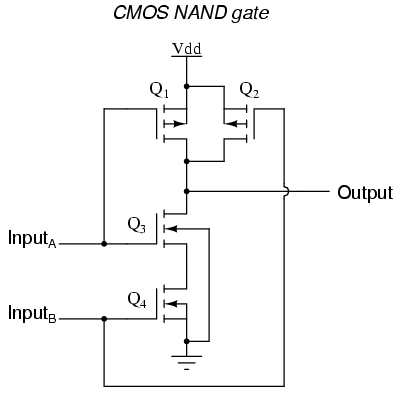ygolo
My termites win
- Joined
- Aug 6, 2007
- Messages
- 6,002
I had to fix some "bugs" in the micro-architecture before proceeding.
1) I changed opcode to opcode + constant. Making that bus 12 bits, instead of the 4 bits it originally was.
2) Added an 8-bit data-bus from execute unit to fetch/decode unit.
Hopefully, you could follow why I needed to make those changes. I'll leave it as an opportunity to the reader to test their understanding
So now, I'll show what happens on all of the buses, during a few cycles so that you get the gist of what is happening in the micro-architecture, as well.
First cycle:
Curr. PC Bus: 0x00
Instruction Bus:0x8000B
PAC Bus: (Addr:0, Source:0, Target 0)
RAC Bus: (Addr1:0,Source1:0,Target1:1,Addr2:0,Source2:0,Target2:0)
MAC Bus: (Addr:0,Source1:0,Target:0)
Op.Code+Constant Bus (OpCode:0x8, Constant: 0X0B)
Data Bus: 0x00
PRD Bus: 0x00
RRD Bus: 0x0000
MRD Bus: 0x00
PWD Bus: 0x00
RWD Bus: 0x0B
MWD Bus: 0x00
New PC Bus: 0x01
Second cycle:
Curr. PC Bus: 0x01
Instruction Bus:0x80101
PAC Bus: (Addr:0, Source:0, Target 0)
RAC Bus: (Addr1:1,Source1:0,Target1:1,Addr2:0,Source2:0,Target2:0)
MAC Bus: (Addr:0,Source1:0,Target:0)
Op.Code+Constant Bus (OpCode:0x8, Constant: 0X01)
Data Bus: 0x00
PRD Bus: 0x00
RRD Bus: 0x0000
MRD Bus: 0x00
PWD Bus: 0x00
RWD Bus: 0x01
MWD Bus: 0x00
New PC Bus: 0x02
Third cycle:
Curr. PC Bus: 0x02
Instruction Bus:0x30001
PAC Bus: (Addr:0, Source:0, Target 0)
RAC Bus: (Addr1:0,Source1:1,Target1:1,Addr2:1,Source2:1,Target2:0)
MAC Bus: (Addr:0,Source1:0,Target:0)
Op.Code+Constant Bus (OpCode:0x3, Constant: 0X01)
Data Bus: 0x00
PRD Bus: 0x00
RRD Bus: 0x0B01
MRD Bus: 0x00
PWD Bus: 0x00
RWD Bus: 0x0A
MWD Bus: 0x00
New PC Bus: 0x03
Fourth cycle:
Curr. PC Bus: 0x03
Instruction Bus:0xA0000
PAC Bus: (Addr:0, Source:0, Target 0)
RAC Bus: (Addr1:0,Source1:1,Target1:0,Addr2:0,Source2:1,Target2:0)
MAC Bus: (Addr:0xA,Source1:0,Target:1)
Op.Code+Constant Bus (OpCode:0xA, Constant: 0X00)
Data Bus: 0x0A
PRD Bus: 0x00
RRD Bus: 0x0A0A
MRD Bus: 0x00
PWD Bus: 0x00
RWD Bus: 0x0A
MWD Bus: 0x0A
New PC Bus: 0x04
Fifth cycle:
Curr. PC Bus: 0x04
Instruction Bus:0xC0000
PAC Bus: (Addr:0, Source:0, Target 1)
RAC Bus: (Addr1:0,Source1:0,Target1:0,Addr2:0,Source2:1,Target2:0)
MAC Bus: (Addr:0xA,Source1:0,Target:0)
Op.Code+Constant Bus (OpCode:0xC, Constant: 0X00)
Data Bus: 0x0A
PRD Bus: 0x00
RRD Bus: 0x0A0A
MRD Bus: 0x00
PWD Bus: 0x0A
RWD Bus: 0x0A
MWD Bus: 0x0A
New PC Bus: 0x05
The lines in red represent buses that changed in the current cycle. The lines in green the ones that changed at all.
1) I changed opcode to opcode + constant. Making that bus 12 bits, instead of the 4 bits it originally was.
2) Added an 8-bit data-bus from execute unit to fetch/decode unit.
Hopefully, you could follow why I needed to make those changes. I'll leave it as an opportunity to the reader to test their understanding
So now, I'll show what happens on all of the buses, during a few cycles so that you get the gist of what is happening in the micro-architecture, as well.
First cycle:
Curr. PC Bus: 0x00
Instruction Bus:0x8000B
PAC Bus: (Addr:0, Source:0, Target 0)
RAC Bus: (Addr1:0,Source1:0,Target1:1,Addr2:0,Source2:0,Target2:0)
MAC Bus: (Addr:0,Source1:0,Target:0)
Op.Code+Constant Bus (OpCode:0x8, Constant: 0X0B)
Data Bus: 0x00
PRD Bus: 0x00
RRD Bus: 0x0000
MRD Bus: 0x00
PWD Bus: 0x00
RWD Bus: 0x0B
MWD Bus: 0x00
New PC Bus: 0x01
Second cycle:
Curr. PC Bus: 0x01
Instruction Bus:0x80101
PAC Bus: (Addr:0, Source:0, Target 0)
RAC Bus: (Addr1:1,Source1:0,Target1:1,Addr2:0,Source2:0,Target2:0)
MAC Bus: (Addr:0,Source1:0,Target:0)
Op.Code+Constant Bus (OpCode:0x8, Constant: 0X01)
Data Bus: 0x00
PRD Bus: 0x00
RRD Bus: 0x0000
MRD Bus: 0x00
PWD Bus: 0x00
RWD Bus: 0x01
MWD Bus: 0x00
New PC Bus: 0x02
Third cycle:
Curr. PC Bus: 0x02
Instruction Bus:0x30001
PAC Bus: (Addr:0, Source:0, Target 0)
RAC Bus: (Addr1:0,Source1:1,Target1:1,Addr2:1,Source2:1,Target2:0)
MAC Bus: (Addr:0,Source1:0,Target:0)
Op.Code+Constant Bus (OpCode:0x3, Constant: 0X01)
Data Bus: 0x00
PRD Bus: 0x00
RRD Bus: 0x0B01
MRD Bus: 0x00
PWD Bus: 0x00
RWD Bus: 0x0A
MWD Bus: 0x00
New PC Bus: 0x03
Fourth cycle:
Curr. PC Bus: 0x03
Instruction Bus:0xA0000
PAC Bus: (Addr:0, Source:0, Target 0)
RAC Bus: (Addr1:0,Source1:1,Target1:0,Addr2:0,Source2:1,Target2:0)
MAC Bus: (Addr:0xA,Source1:0,Target:1)
Op.Code+Constant Bus (OpCode:0xA, Constant: 0X00)
Data Bus: 0x0A
PRD Bus: 0x00
RRD Bus: 0x0A0A
MRD Bus: 0x00
PWD Bus: 0x00
RWD Bus: 0x0A
MWD Bus: 0x0A
New PC Bus: 0x04
Fifth cycle:
Curr. PC Bus: 0x04
Instruction Bus:0xC0000
PAC Bus: (Addr:0, Source:0, Target 1)
RAC Bus: (Addr1:0,Source1:0,Target1:0,Addr2:0,Source2:1,Target2:0)
MAC Bus: (Addr:0xA,Source1:0,Target:0)
Op.Code+Constant Bus (OpCode:0xC, Constant: 0X00)
Data Bus: 0x0A
PRD Bus: 0x00
RRD Bus: 0x0A0A
MRD Bus: 0x00
PWD Bus: 0x0A
RWD Bus: 0x0A
MWD Bus: 0x0A
New PC Bus: 0x05
The lines in red represent buses that changed in the current cycle. The lines in green the ones that changed at all.





